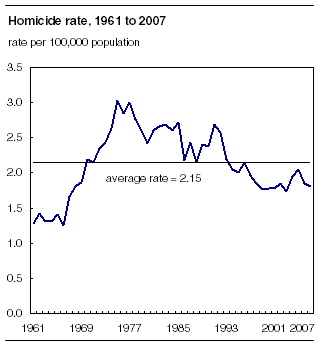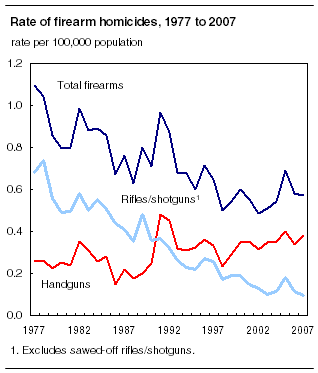Common menu bar links
Homicides
Archived Content
Information identified as archived is provided for reference, research or recordkeeping purposes. It is not subject to the Government of Canada Web Standards and has not been altered or updated since it was archived. Please "contact us" to request a format other than those available.

Police reported 594 homicides in Canada in 2007, 12 fewer than in 2006. Stabbings accounted for one-third of the homicides in 2007 and another third involved the use of a firearm. Handguns were used in two-thirds of all firearm homicides, primarily in urban areas. Police reported that one in five homicides were gang-related.
After rising through much of the 1960s and early 1970s, Canada's homicide rate has been on a general downward trend since the mid-1970s. This trend continued in 2007 with a further 3% decline in the national homicide rate.

For the past 20 years, shootings and stabbings have each accounted for about one-third of all homicides. This was also the case in 2007, as there were 190 stabbings and 188 shootings.
While the overall rate of homicides committed with a firearm has generally been decreasing since the mid-1970s, the use of handguns has been on the rise. In 2007, handguns were used in two-thirds of all firearm homicides, up from about one-quarter 20 years ago.
Police reported that one in five homicides were gang-related in 2007. Gang-related homicides have been increasing since this information was first collected in 1991.
Use of handguns to commit homicide on the rise
In 2007, 126 homicides were committed with a handgun, 16 more than in 2006. The rate of homicides committed with a handgun has more than doubled over the past 20 years. At the same time, the use of rifles/shotguns to commit homicide continues to decline.
Homicides committed with handguns are primarily an urban phenomenon. Within the nation's metropolitan areas, 81% of all firearm-related homicides were committed with a handgun in 2007, compared with 29% in the rest of Canada.
Note to readersAggregate statistics on homicide for 2007 were first released in The Daily on July 17, 2008, as part of a wide-ranging analysis of police-reported crime. This report represents a more detailed examination of the police-reported homicide data. The Criminal Code classifies homicide as first degree murder, second degree murder, manslaughter or infanticide. Deaths caused by criminal negligence, suicide, and accidental or justifiable homicide are not included. |

Gang-related homicides continue to increase
Gang-related homicides, which include the killing of gang members as well as innocent bystanders, have been increasing since this information was first collected in 1991.
In 2007, there were 117 homicides reported as gang-related by police, 16 more than in 2006. This accounted for about 1 in every 5 homicides reported to police.
Firearms were used more often in gang-related homicides than in other types of murder. In 2007, just over two-thirds of gang-related homicides were committed with a firearm, compared with about 20% of homicides that did not involve gangs.
Youth homicides drop in 2007
After reaching an all-time high in 2006, the rate of youth accused of homicide dropped in 2007. There were 74 youth accused of homicide, 11 fewer than in 2006. However, this still resulted in the second highest youth homicide rate since data were first collected in 1961.
Youth homicides often involve gangs. In 2007, of all homicides in which a youth was involved as an accused person, about one-third were reported by police as gang-related.
Most victims knew their killer
As in most years, in 2007, over 80% of solved homicides were committed by someone known to the victim. However, there are differences between male and female victims.
Male homicide victims were most likely to be killed by an acquaintance, someone known to them through a criminal relationship or a stranger. In contrast, female homicide victims were most frequently killed by a current or former intimate partner, or other family member.
| Male victims killed by acquaintances, female victims killed by partners | |||
|---|---|---|---|
| Victim killed by | Male victims | Female victims | Total victims |
| % | |||
| Spouse | 5 | 38 | 16 |
| Other family member | 15 | 23 | 17 |
| Boyfriend/girlfriend | 3 | 5 | 4 |
| Acquaintance | 40 | 18 | 33 |
| Criminal relationship | 18 | 8 | 15 |
| Stranger | 20 | 8 | 16 |
Homicide rates highest in the West and North
The western provinces and the territories have consistently reported the highest homicide rates in the country.
Last year was no exception as Manitoba reported the highest homicide rate among the provinces, followed by Saskatchewan, Alberta and British Columbia. Prince Edward Island and Newfoundland and Labrador continued to report the lowest rates.
Manitoba police reported 62 homicides, 23 more than in 2006, giving the province its highest rate since data were first available in 1961. Most of the increase occurred in small urban and rural areas of the province.
However, other provinces reported much lower than average rates. British Columbia's homicide rate was the second lowest in that province since 1961, while Quebec's homicide rate was at its lowest point in over 40 years.
Among the larger metropolitan areas, Winnipeg, Edmonton, and Calgary had the highest homicide rates. Saskatoon, although a smaller metropolitan area, reported the highest homicide rate of all cities (3.60 homicides per 100,000 population).
Toronto police reported 111 homicides in 2007, almost one-fifth of the national total. However, after taking population into account, the Toronto homicide rate is similar to that of other large Canadian cities.
Available on CANSIM: tables 253-0001 to 253-0006.
Definitions, data sources and methods: survey number 3315.
The Juristat article "Homicide in Canada, 2007," Vol. 28, no. 9 (85-002-XWE, free), is now available. From the Publications module of our website, under Free Internet publications, choose Crime and justice, then Juristat.
For more information, or to enquire about the concepts, methods or data quality of this release, contact Information and Client Services (toll-free 1-800-387-2231; 613-951-9023), Canadian Centre for Justice Statistics.


 Table(s).
Table(s).